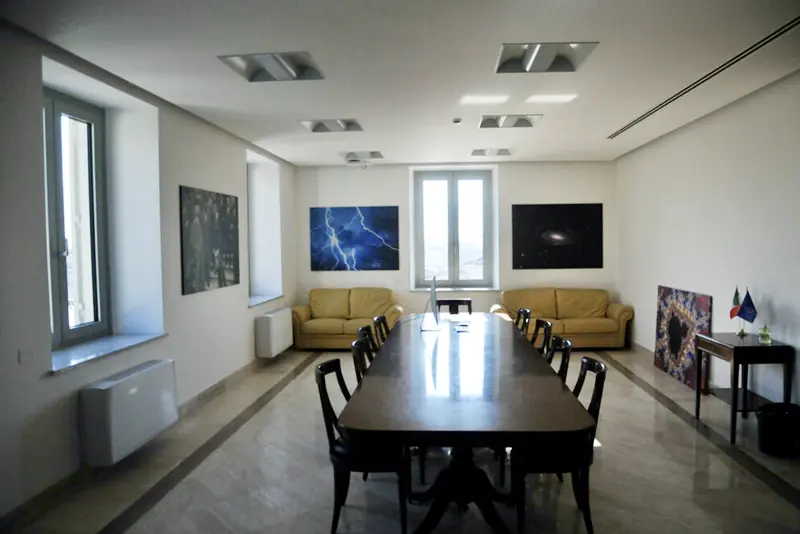research
CREF promotes original and high-impact lines of research, based on physical methods, but with a strong interdisciplinary character and in relation to the main problems of the modern knowledge society.
Principal Research Lines
- Innovation and predictive scenarios for sustainability
- Complexity in the natural, social and economic sciences
- The socio-economic impact and technological innovation of artificial intelligence
- Neuroscience and quantitative neuroimaging
- Photonic Technologies and Artificial Intelligence
- Physics for Cultural Heritage
Individual research areas
History of Physics
third mission
The CREF was born with a dual soul: a research centre and a historical museum. Its aim is to preserve and disseminate the memory of Enrico Fermi and to promote the dissemination and communication of scientific culture.
Young researchers
Higher education and projects for young researchers
Open positions...
Il CREF indice una selezione pubblica, per titoli e colloquio, per il conferimento di n. 1 assegno di...
No posts found
NEWS
Networks with Many Structural Scales: A Renormalization Group Perspective

We live in a world of interconnected systems. From the intricate web of the internet to the complex network of neurons in our brains, understanding how these connections work is crucial.
One key concept in understanding these complex systems is “scale invariance.” This means that the system looks similar at different levels of detail. For example, a fractal, like a snowflake, exhibits scale invariance: if you zoom in on a tiny part, you’ll see the same intricate patterns as the whole snowflake.
Similarly, in a truly scale-invariant network, the overall structure remains consistent regardless of the scale at which you observe it.
The Renormalization Group is a set of techniques to study the effects of such scale transformations in physical systems.However, determining if a network truly exhibits scale invariance can be challenging, especially for biological and technical networks, such as organisms’ metabolic pathways and the Internet.
A research team from CREF, in collaboration with Sapienza Università di Roma, Roma3, Univesidad de Granada and ISC-Istituto dei sistemi complessi, has broadened the scope of renormalization to arbitrary networked systems beyond grid structures. In a recent paper, Villegas and al. developed a new framework, the “Laplacian Renormalization Group,” to investigate scale invariance in networks. This method analyzes how information flows and spreads within the network, revealing patterns that emerge at different levels.
“Imagine an oil stain spreading across a network,” explains Pablo Villegas. “If the stain maintains its characteristics regardless of its size and the size of the network itself, we are likely dealing with a scale-invariant network.”
Applying this framework to the human brain, researchers found intriguing results.
“We studied the connectome, a map of neural connections in the brain,” says Villegas. “Our findings suggest that the human brain exhibits scale-invariant properties, resembling hierarchical modular networks. This is akin to a Matrioska doll, with intricate structures nested within each other.”
These findings have significant implications for our understanding of brain function. By unraveling the principles of scale invariance in the brain, we can gain valuable insights into how this complex organ operates and how it might be affected by various conditions.
The paper “Networks with Many Structural Scales: A Renormalization Group Perspective”, has been published 5 February, 2025 on Phys. Rev. Lett. 134, 057401
DOI: https://doi.org/10.1103/PhysRevLett.134.057401
Authors:
Anna Poggialini (Sapienza, CREF), Pablo Villegas (CREF, Universidad de Granada), Miguel A. Muñoz (Universidad de Granada), Andrea Gabrielli (CREF, Roma Tre, Istituto dei Sistemi Complessi (ISC)-CNR)
Contact author: pablo.villegas@cref.it
share on:
Via Panisperna 89 A – 00184 Roma
PEC: centrofermi@pec.centrofermi.it
CUU: UF5JTW
Phone: +39 06 4550 2901
VAT: 06431991006
CF: 97214300580
Mail: via Panisperna 89a – 00184 Rome
Guest Entrance: Piazza del Viminale 1 – 00184 Rome
© Centro Studi e Ricerche Enrico Fermi. All rights reserved | Cookie Policy







